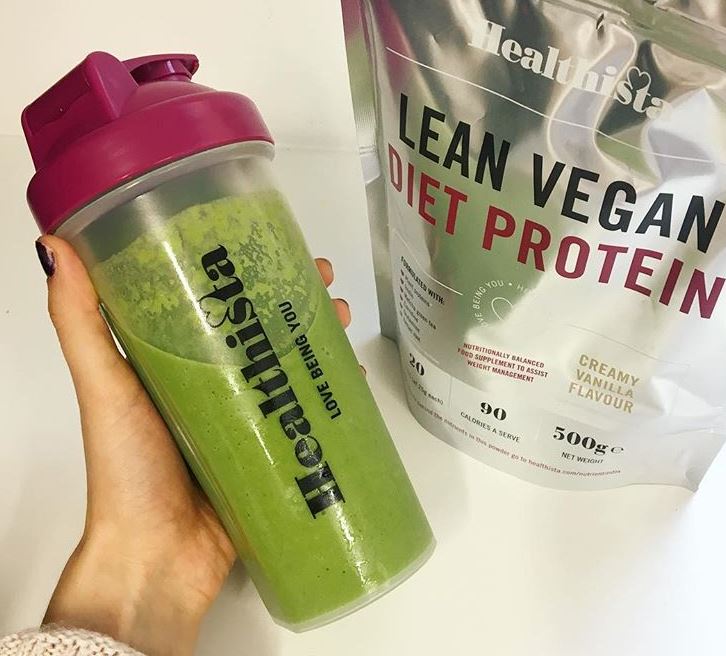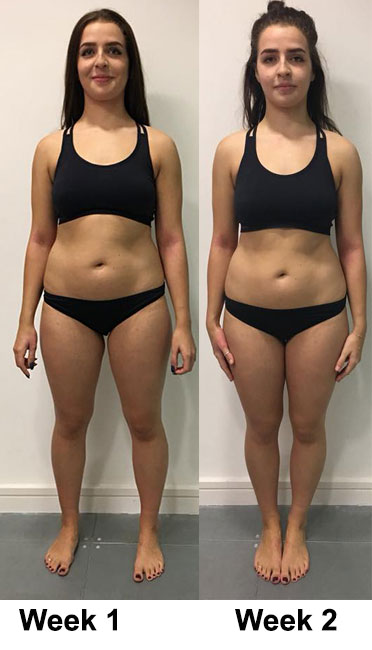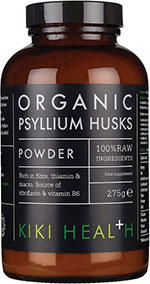Healthista’s Vanessa Chalmers used intermittent fasting to lose a staggering stone in eight weeks with PT Ben Camara at No1 Fitness. In the second week of her transformation diary, she explains the principles of intermittent fasting
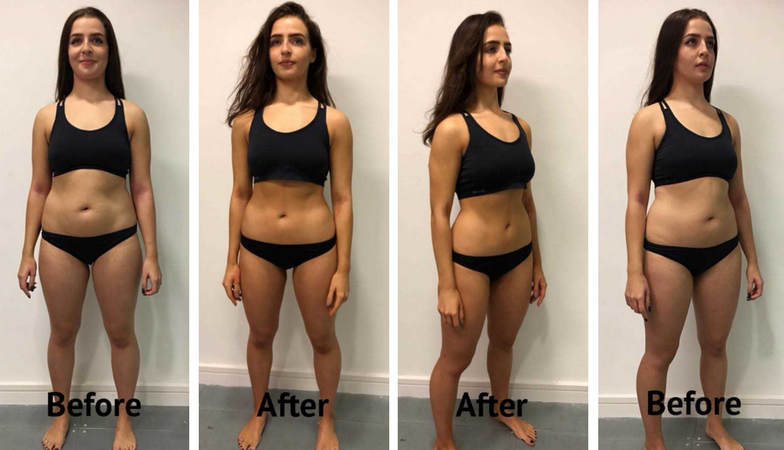
Welcome back to my weight loss transformation diary. It’s the beginning of week two (you can read about week one and my results here), and I’m quite astonished at how much the body changes when you cut out the bad stuff. So far I have stuck by the rules, avoiding any alcohol, bread, pasta, junk food or anything ‘out a packet’ (apart from a tasting session for a best savoury snacks article – we really do do taste testing at Healthista HQ!), and the results are reflected. I am 1.6kg (3.5lbs) lighter and 3cm have already come off my waist.
It’s only week two and 3cm have already come off my waist
But Boditrax, a body composition test I do weekly at No1 Fitness, shows I haven’t lost any body fat mass yet, in fact, it’s gone up 0.6 per cent to 25.7 per cent. Ben, my PT, says this could be due to a lot of things, but quite likely it’s because I haven’t gone to the loo that day. Yep, poo counts as body fat.
Body fat mass is the actual weight of fat in your body, and is vital to your basic bodily functions such as regulating body temperature, storing vitamins and cushioning joints. The lower it is, the lower risk of things such as high blood pressure, heart disease, diabetes and cancer. You may prefer to use a body fat percentage as a goal, rather than a weight, using photos such as below as a guideline.
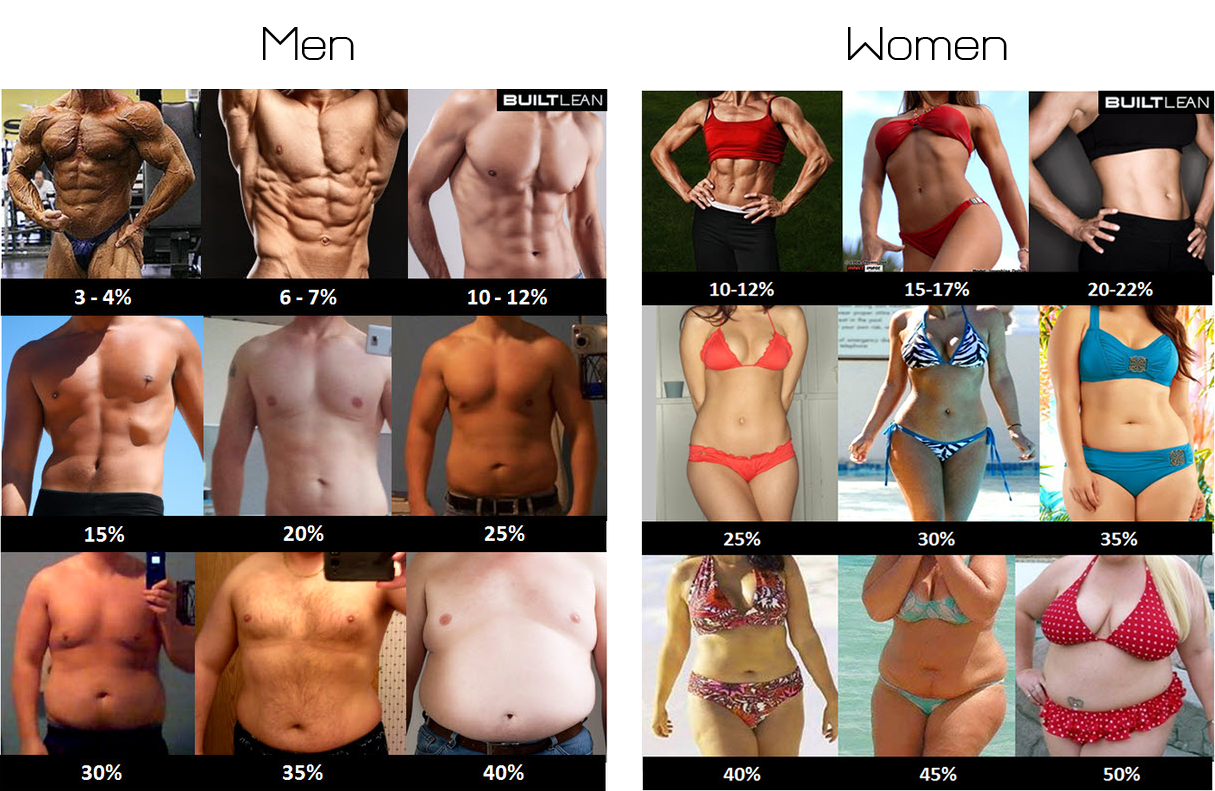
Intermittent fasting for weight loss
Intermittent fasting is something I wish I had discovered years ago. Mark, personal trainer and in-house nutritionist at No1 Fitness, suggested fasting was best for me because my previous eating window was too large. Breakfast was at 9.30am and my eating was spread over the day for up to 12 hours. I can’t change the time I finish eating (my family has always eaten after 8pm for commute reasons, sigh), and so it was breakfast that needed to be pushed back.
I’m fasting for around 15-16 hours a day which includes my sleep, what Mark calls a ‘cyclical fashion’. This fast is known as the 16/8 method, but another approach is the 5:2, in which during the week you fast (or restrict eating to only 500 kcals/day) on two non-consecutive days and eat normally on the other five days. Both have gained a bit of a buzz recently, and a search on YouTube will yield endless ‘it worked for me’ stories.

Waiting till noon to have breakfast in the first few days left me feeling grouchy and lacking in energy, but as I went into week two it felt so natural and I was seeing a difference fast (excuse the pun). ‘Fasting has a multitude of benefits’, says Mark. ‘Firstly it helps reduce calorie intake which is the most important thing when it comes to body fat reduction.’ Indeed, my calorie intake felt like it had significantly dropped because there were simply less hours to eat in. ‘It also helps us deal with hunger signals better, meaning that we often want to snack and graze less throughout the day. Finally eating over a restricted time period is beneficial for your digestion’ – that is if you were to make your eating window 11am – 7pm, giving enough time to digest before sleep.
The body will need to use fat stores as a source of energy
The nitty gritty of the weight loss is to do with energy sources. In an fasting guide for Healthista, nutritionist May Simpkin says, ‘After a meal, the digestive system processes the food you have just eaten; digesting and absorbing, so that the body can use the nutrients the food has provided. This process takes around 4 to 5 hours, during which time the body will prioritise using the carbohydrates provided as part of this meal as its preferred energy source, rather than rely on fat stored in the body. Following a meal, insulin levels will be high and when insulin levels are high, the body is less likely to use fat as fuel. However, after this point, the body will need to use its fat stores as a source of energy, which will result in weight loss.’

Intermittent fasting can reduce the risk of disease, too
‘The health benefits also include a reduced risk of developing type 2 diabetes by improving insulin sensitivity,’ says Mark, who swears by fasting and occasionally does it for 24 hours. ‘When we fast for longer periods, the cells in our body initiate a cellular “waste removal” process called autophagy. This involves the cells breaking down and metabolizing broken and dysfunctional proteins that build up inside cells over time. Increased autophagy may provide protection against several diseases, including cancer and Alzheimer’s disease.’
Adults age 0.6 years slower if they eat 25 per cent less calories each day
Researcher Dr Rozalyn Anderson agrees, saying in the most recent edition of The Journal of Gerontology that by reducing calories, the body is able to use energy from food differently, become more resilient, and ‘instead of fighting cancer or cardiovascular disease individually, target the full spectrum of disease simultaneously’. She even made the bold claim that wrinkles are not inevitable with calorie restriction. One landmark study earlier this year that showed adults age 0.6 years slower if they eat 25 per cent less calories each day – roughly 1875 for men and 1,500 for women.
What I ate this week
Is there anything I can have in those first few hours of the day? Of course, water is allowed. Coffee has also become the norm for me for the first time in my life, and I notice bulletproof coffee is something fasters are a fan of. This stuff is caffeine mixed with grass-fed butter, and MCT oil or coconut oil. Apparently, it gives slow releasing energy to keep you going through the fast.
This is how a typical day looks for me in week two:
6.30am: A shake of Healthista Body Food before a 7am workout.
10am: Coffee with almond milk
12pm: Breakfast – a green smoothie. 40g raspberries, 170ml kefir (a fermented probiotic drink I have every day to control my eczema. Almond milk, rice milk or coconut milk will do too), half a banana, a tablespoon of coconut oil, Healthista Lean Vegan Diet protein powder in chocolate and two handfuls of spinach. 390 calories.
3pm: Lunch – chicken salad. 120g cooked chicken breast. 20g quinoa. 40g avocado (or other fat, such as walnuts or feta cheese). 100g nectarine sliced. Lots of rocket and watercress. 380 calories.
5pm: Sometimes another snack of a piece of fruit and teaspoon of nut butter. Up to 150 calories.
8pm: Dinner – Stir fry. 130g chicken. 50g mushrooms. 75g stir fry mix (a whole packet feeds four, the same with a beansprouts mix). 25g kale. 10ml Meridian tamari soy sauce. 270 calories.
Dessert – 60g Alpro coconut or plain yoghurt, a scoop of Healthista Lean Vegan Diet protein in vanilla, 40g blueberries, 40g strawberries and if I’m really cheeky, 70g brazil nuts. 170 calories.
How much exercise is enough?
I can’t help wondering if half an hour fitness slots at No1 is enough exercise, especially as I am sat on my arse for way over 12 hours a day. I was soon shown wrong. I take a class with Carl at 7am and I was practically begging for my life. At No1, you’ll find that often you are the only one in a fitness slot, with a maximum of six people, meaning you get a lot of one-to-one attention.
If you push your best for half an hour, you can stay lean
As soon as I entered that class, Carl had an agenda to work me to the bone, until I was almost in tears, pretending my face was screwed up due to concentration. ‘Half an hour is more than enough work’, says Carl at the end as I whimper to catch my breath. I learn that he is a UK Boxing Champion. ‘I was working out for three hours a day. But that was because I was professional. You see people in the gym now who are doing cardio for an hour thinking that’s the best way to get fit. Absolutely not. If you push to your best for half an hour, you can stay lean’. The hard part is only a minute percentage of your full day – once it’s over, it’s forgotten about.
A typical fitness slot at No1 Fitness:
https://www.instagram.com/p/BbE0Z7xBcgs/?hl=en&taken-by=vanessa_chalmers
Luckily I am a morning person so have quite easily slipped into the routine of five morning gym sessions a week (three and a half hours). Ben and I continue to get the muscles ‘switched on’ and moving in the right direction. ‘For example, when you’re lunging we are looking to get you lower, better form, slowing it down and adding weight as well to make the muscles work harder’, says Ben. Indeed, I am learning a lot about the proper way to perform movements, some of which I was clearly doing wrongly before. For example, I had never passed hip height with a squat before, believing my hips weren’t flexible enough, so warming up the hips with deep lunge stretches before a workout becomes an essential starter. You can see demonstrations such as this below (how to perform a squat), on No1 Fitness Instagram.
https://www.instagram.com/p/BbAUgQ2H-rt/?taken-by=no1_fitness
Results at the end of week two
| Before/Week 1 | Beginning week 2 | Beginning week 3 | |
| Weight | 65.7kg | 64.1kg | 63.3kg |
| Body fat | 25.1% | 25.7% | 23.4% |
| Hip | 102.5cm | 101.6cm | 96cm |
| Waist below belly button | 91cm | 88cm | 84.7cm |
| Overall weight loss | N/A | 1.6kg | 2.4kg |
| Overall cm loss | N/A | 3.9cm | 12.8cm |
Three things I learnt this week
1. What hunger is: My belly rumbles at 7am are not hunger. It’s just my belly saying ‘good morning’. It subsides within 30 seconds – normally the time in which I’ve grabbed a snack and eaten it.
2. Brits love a sugar laiden hot drink: In Autumn, the pumpkin-spice-cinnamon-gingerbread-whipped-cream frappe’s are on EVERY street corner in London. Luckily, I’m already put off knowing how much sugar they contain. In a study by Action for Sugar, it was found chain coffee shop hot drinks contain up to 25 teaspoons of sugar, the same amount in three cans of cola. (Starbucks Hot Mulled Fruit was the worst, in case you were wondering, followed by Costa’s Chai Latte).
3. Freddos for the win: Starting a conversation with women in the changing rooms is well worth it. You leave with more inspiration, motivation, and tips such as ‘Freddos are the best treat because they are 95 calories and so worth it’ – coming from a girl with rocking abs.
3 products that helped
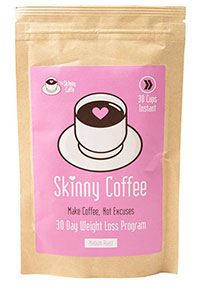
Buy for £24.95 from Holland and Barrett
Ben recommends I take a fibre supplement to get things moving…. swiftly. Psyllium husk supplement (a soluble fibre), such as that from KIKI Health, provides 2.7g of fibre per serving and can be added to smoothies. It absorbs water to form a gel-like substance, which helps to soften the stools and get them sliding (sorry). What’s more, by expanding in the stomach, it can help you feel fuller, and some recommend taking it before meals to curb overeating and reap weight loss benefits.
Buy for £19.95 from the Healthista Shop
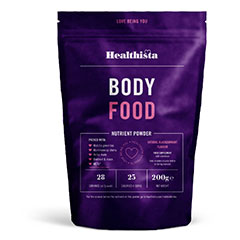
Buy for £18.95 from the Healthista Shop
Come back every week to read Vanessa’s week by week diary of her weight loss transformation with Ben Camara at No1 Fitness, with tips and advice from the experts.
Ben Camara has worked with some of the most famous faces in the world with training and health coaching clients including Madonna, Kate Moss and Vogue photographers Mert & Marcus. Having carved out a career in professional football, Ben Camara wanted his next career step to allow him to continue working in the field that he was passionate about, that of health, fitness and nutrition. He and Harry Thomas co-founded No1 Fitness seven years ago, offering bespoke personal training in two locations in London.
Follow on Instagram or visit No1 Fitness website.
READ MORE:
Fasting for weight loss – the nutritionist’s guide
Vanessa’s weight loss transformation week one: why a high protein diet matters
8 week weight loss transformation
Do I need to take protein powder?
Like this article? Sign up to our newsletter to get more articles like this delivered straight to your inbox.




